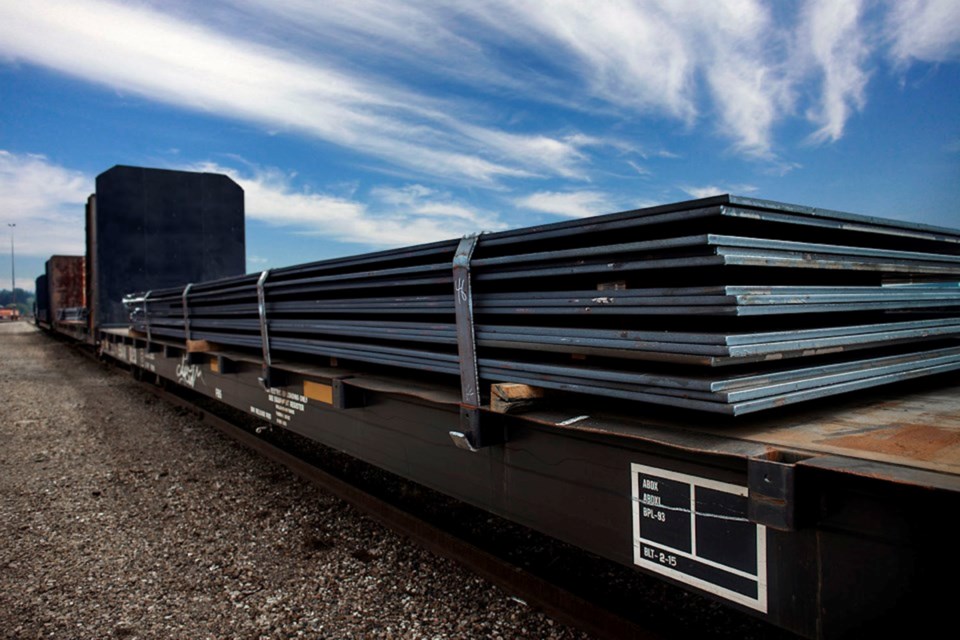Algoma Steel’s third-quarter results for 2023 were not all roses and chocolate.
The Sault Ste. Marie steelmaker posted a quarterly loss of $69.8 million, but Algoma CEO Michael Garcia maintains this is only a slight bump in the road as North American steel markets, as well as their own in-house operating efficiencies, should improve in the coming months.
In a Valentine’s Day web call with analysts, Garcia said it‘s been a challenging past two quarters, going by production and shipping levels, but things should return to normal operating levels over the next few months.
The company attributes their net loss largely to a drop in steel production, weak steel pricing, and the increased inflationary costs in raw materials and consumables used in steel production, namely metallurgical coke, natural gas, alloys and scrap steel.
Algoma shipped 458,341 tons of steel during the quarter, sequentially better than 435,000 tons that went out the door to customers in the second quarter. Yet that's below than what was anticipated.
Much of that shortfall is being attributed to delays in commissioning a first phase of upgrades to its plate mill.
The $135-million plate mill modernization project is the vital to the company’s production of its catalogue of rolled and heat-treated products, particularly in manufacturing an “enhanced” high-strength abrasion resistant product and products for military applications.
Algoma’s third quarter for 2023 ended on Dec. 31. The company’s 2023 fiscal year runs from April 1 to March 31. The fourth quarter results will come out sometime in the spring.
Revenue for the third quarter totalled $567.8 million, down 47 per cent from the $1.06 billion posted during the same period last year. Revenue per ton of steel sold was $1,239, down 35.7 per cent from $1,927.
Loss from operations was $65.7 million, compared to income of $446.1 million in the prior-year quarter.
Last summer and fall, Algoma encountered multiple operational and production issues with a coke oven conveyor belt fire, the delays with the plate mill upgrades and a COVID outbreak that left them shorthanded at its major rolling mill, the Direct Strip Production Complex.
Algoma signed a long-term contract to buy metallurgical coke from an outside supplier to feed the furnace and maintain production at normal levels.
“Our demand for coke at the blast furnace outstrips our production capacity,” said Garcia.
Garcia said plate shipments returned to normal at end of the third quarter and he expects shipments in 2023 to be more consistent with their historic production levels.
Following through on a second phase of upgrades to the plate mill could involve downtime of about 40 days - roughly 60,000 tons of steel production – but Garcia said market conditions will dictate whether those improvements take place this year.
Cash-wise, Algoma said it’s in a good position with $245 million in the bank and $239 million available on credit.
It wasn’t all negative news. The construction of two electric arc furnaces (EAF), the first ever at the 120-year-old steel producer, remains on schedule and on budget.
The $703-million project will eliminate blast furnace and basic oxygen steelmaking operations and clean up Algoma’s carbon emissions by 70 per cent a year.
The furnaces come online in mid-2024 with raw steel production capacity of 3.7 million tons. Approximately $220 million has been spent on the EAF project as of the end of December. The company reports work as been completed on the foundation and building erection has started.
Cranes are on site and the first column of the main EAF building was going up on Feb. 14, an “exciting milestone in the project,” said Garcia.
In reflecting on 2022, Garcia said North American steel prices peaked in March at the start of the Ukraine War then started to plunge, finally bottoming out in November. The company is encouraged by the rebound in pricing for hot rolled coiled steel and continued robust plate prices, all good signs for a stable year ahead.
Garcia said Algoma’s order book and contract sales to customers in the auto, construction and oil and gas sectors look healthy, and they expect higher steel shipments and sales to report by the time the fourth-quarter results are in.




